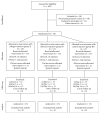Comparison between Collagen and Lidocaine Intramuscular Injections in Terms of Their Efficiency in Decreasing Myofascial Pain within Masseter Muscles: A Randomized, Single-Blind Controlled Trial
- PMID: 29973970
- PMCID: PMC6008702
- DOI: 10.1155/2018/8261090
Comparison between Collagen and Lidocaine Intramuscular Injections in Terms of Their Efficiency in Decreasing Myofascial Pain within Masseter Muscles: A Randomized, Single-Blind Controlled Trial
Abstract
Background and objective: A novel option for myofascial pain (MFP) management and muscle regeneration is intramuscular collagen injections. The aim of the study was to evaluate the efficiency of intramuscular injections of collagen and lidocaine in decreasing MFP within masseter muscles.
Methods: Myofascial pain within masseter muscles was diagnosed on the basis of the Diagnostic Criteria for Temporomandibular Disorders (II.1.A. 2 and 3). A total of 43 patients with diagnosed MFP within masseter muscles were enrolled to the study (17 male and 26 female, 40 ± 3.8 years old) and randomly divided into three groups. The first group received injections using 2 ml of collagen MD Muscle (Guna), the second group received 2 ml of 2% lidocaine without a vasoconstrictor, and the third group 2 ml of saline as a control (0.9% NaCl). All patients received repeated injections at one-week intervals (days 0 and 7). The visual analogue scale was used to determine pain intensity changes during each follow-up visit (days 0, 7, and 14) in each group. The masseter muscle activity was measured on each visit (days 0, 7, and 14) with surface electromyography (sEMG) (Neurobit Optima 4, Neurobit Systems).
Results: We found that sEMG masseter muscle activity was significantly decreased in Group I (59.2%), less in Group II (39.3%), and least in Group III (14%). Pain intensity reduction was 53.75% in Group I, 25% in Group II, and 20.1% in Group III.
Conclusions: The study confirmed that intramuscular injection of collagen is a more efficient method for reducing myofascial pain within masseter muscles than intramuscular injection of lidocaine.
Figures



Similar articles
-
Intramuscular Injections and Dry Needling within Masticatory Muscles in Management of Myofascial Pain. Systematic Review of Clinical Trials.Int J Environ Res Public Health. 2021 Sep 10;18(18):9552. doi: 10.3390/ijerph18189552. Int J Environ Res Public Health. 2021. PMID: 34574476 Free PMC article.
-
Evaluation of the effects of occlusal splint and masseter muscle injection in patients with myofascial pain: a randomised controlled trial.J Oral Facial Pain Headache. 2024 Sep;38(3):64-76. doi: 10.22514/jofph.2024.028. Epub 2024 Sep 12. J Oral Facial Pain Headache. 2024. PMID: 39800573 Free PMC article. Clinical Trial.
-
Lidocaine Injection in the Intramuscular Innervation Zone Can Effectively Treat Chronic Neck Pain Caused by MTrPs in the Trapezius Muscle.Pain Physician. 2015 Sep-Oct;18(5):E815-26. Pain Physician. 2015. PMID: 26431135
-
Reduction of pain and EMG activity in the masseter region by trapezius trigger point injection.Pain. 1993 Dec;55(3):397-400. doi: 10.1016/0304-3959(93)90018-K. Pain. 1993. PMID: 8121703
-
Effect of Local Anesthetic Versus Botulinum Toxin-A Injections for Myofascial Pain Disorders: A Systematic Review and Meta-Analysis.Clin J Pain. 2019 Apr;35(4):353-367. doi: 10.1097/AJP.0000000000000681. Clin J Pain. 2019. PMID: 30589660
Cited by
-
Evaluation of laser acupuncture versus physical therapy intervention in management of bruxism in children: a randomized controlled trial.BMC Oral Health. 2025 Mar 5;25(1):341. doi: 10.1186/s12903-025-05626-x. BMC Oral Health. 2025. PMID: 40045349 Free PMC article. Clinical Trial.
-
Autologous Stem Cells Transplants in the Treatment of Temporomandibular Joints Disorders: A Systematic Review and Meta-Analysis of Clinical Trials.Cells. 2022 Aug 30;11(17):2709. doi: 10.3390/cells11172709. Cells. 2022. PMID: 36078117 Free PMC article.
-
Intramuscular Injections and Dry Needling within Masticatory Muscles in Management of Myofascial Pain. Systematic Review of Clinical Trials.Int J Environ Res Public Health. 2021 Sep 10;18(18):9552. doi: 10.3390/ijerph18189552. Int J Environ Res Public Health. 2021. PMID: 34574476 Free PMC article.
-
Pharmacological Treatments of Temporomandibular Disorders: A Systematic Review Including a Network Meta-Analysis.Drugs. 2024 Jan;84(1):59-81. doi: 10.1007/s40265-023-01971-9. Epub 2023 Dec 16. Drugs. 2024. PMID: 38103150 Free PMC article.
-
Bruxism in a Child with Trisomy 21 (Down Syndrome)-Case Report.J Clin Med. 2024 Jun 24;13(13):3679. doi: 10.3390/jcm13133679. J Clin Med. 2024. PMID: 38999245 Free PMC article.
References
-
- Reissmann D. R., John M. T., Aigner A., Schön G., Sierwald I., Schiffman E. L. Interaction between awake and sleep bruxism is associated with increased presence of painful temporomandibular disorder. Journal of Oral & Facial Pain and Headache. 2017;31(4):299–305. doi: 10.11607/ofph.1885. - DOI - PMC - PubMed
Publication types
MeSH terms
Substances
LinkOut - more resources
Full Text Sources
Other Literature Sources
Medical

